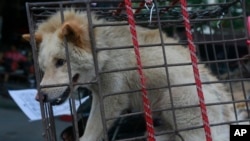The recent, devastating Ebola epidemic in western Africa is a reminder of how vulnerable we are to diseases carried by animals. A new report suggests that vaccinating wild animals could prevent lethal diseases from spreading to people.
A number of deadly diseases begin as infections in animals that jump the species barrier.
Michael Jarvis, a molecular virologist from Plymouth University in Britain, lists several infections that fit this category.
“We’ve got MERS, SARS, HIV, Ebola, Marburg, Nippa, Hendra,” said Jarvis. "So all of these viruses, none of them actually were known before they actually emerged into the human population.”
Many of those diseases are transmitted to humans through contact with animal carcasses. Ebola and AIDS spread through the gathering and consumption of bush meat.
Jarvis is spearheading research that might have prevented last year's Ebola outbreak and could potentially thwart future animal-to-human transmissions.
The strategy involves self-disseminating vaccines. Animals would be inoculated with a harmless virus, called cytomegalovirus, which has been engineered to carry the disease-causing pathogen. It would be delivered through food that is left where wild animals roam. Each species, says Jarvis, has its own version of the virus so it can only infect a particular group of animals.
In the journal Expert Review of Vaccines, Jarvis described his work with such a strategy.
“The idea would be that you would inoculate a few animals and that they would then, just through normal interaction (with other animals) would then spread the inoculated vaccine through the population,” said Jarvis.
Jarvis hopes to drum up interest in the technology that - while promising - has received relatively little attention and funding.
He says the challenge is discovering vaccines for particular animal-transmitted diseases and developing methods for distributing the targeted vaccines.
While the task sounds daunting, the technology to make vaccines is available and the disease-prevention strategy, according to Jarvis, could move from the laboratory into jungles and forests in the next five years.




